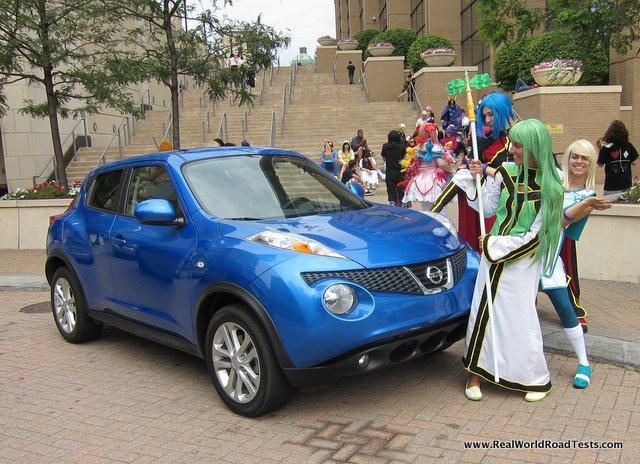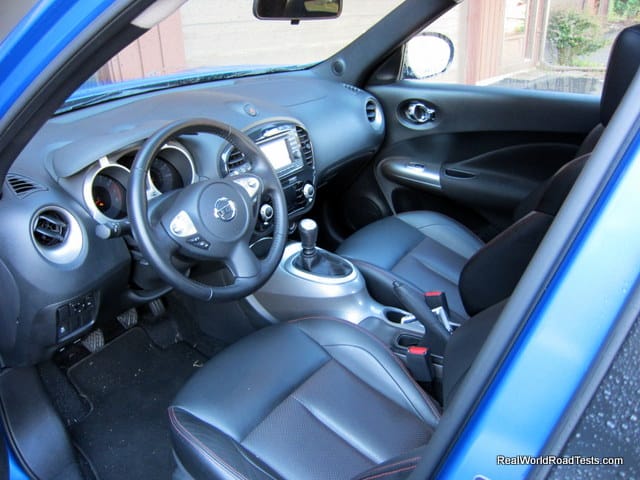Overview
What the heck is this thing you may ask? My first response would be “It’s a 2012 Nissan Juke.” What’s a Juke? And why does it look that? Well, that’s what makes the Juke so interesting. Right off the bat, people know you’re driving something different than the many ho-hum vehicles out there.
So let me explain. The Juke is many things. First and foremost, it’s not big. In fact, it’s based on Nissan’s B-segment (subcompact) platform, similar to the Versa and the Cube. Secondly, it’s higher off the ground than your typical car, it’s available in all-wheel drive (AWD), and it has a rear hatch, so it’s got some SUV DNA in it too. Thirdly, it has a sporty coupe-like appearance and bold styling. All these characteristics in one car mean that the Juke is a Crossover and thus, does not fall into any one particular category. It’s part subcompact, part sporty car, part SUV, but it’s 100% different than anything we’ve ever seen before.
The Juke was first introduced for the 2011 model year. There are no significant changes for 2012. Our test car is the Juke SL with front-wheel drive (FWD) and a 6-speed manual transmission.
It’s easy to look at a car that’s different than the norm without understanding why it was designed to look that way, and judge it based on pure ignorance. What we’d like to do is explain its design so you (our faithful readers) will have a better understanding of the Juke, and why it was designed to look the way it does.
Alfonso Albaisa, Vice President of Nissan Design of Europe, explained that Nissan wanted to have fun with a new crossover and make a real statement. Their goal was to push the boundaries of design to capture the attention of young people with an active lifestyle – those who enjoy snowboarding, motorcycling, etc. Its styling was also inspired by dune buggies and rally cars. This was the mindset behind the design of the Juke.
In front, we think the Juke looks wacky with a little too much going on. Maybe it’s a blend of too many styles of art that don’t exactly work well together? But then again, maybe it’s just those Nissan designers having some fun seeing how many heads they’ll turn. Interestingly, what appears to be the alien eye-like headlights protruding the front fenders are actually the turn signals and side lights. What seem to be fog lights just below the front grille are actually halogen headlights inspired by auxiliary lights from a rally car. The fog lights are located in the skid plate-like air intake assembly that also displays large circular slots for cooling, and to enhance the Juke’s rally-inspired look.
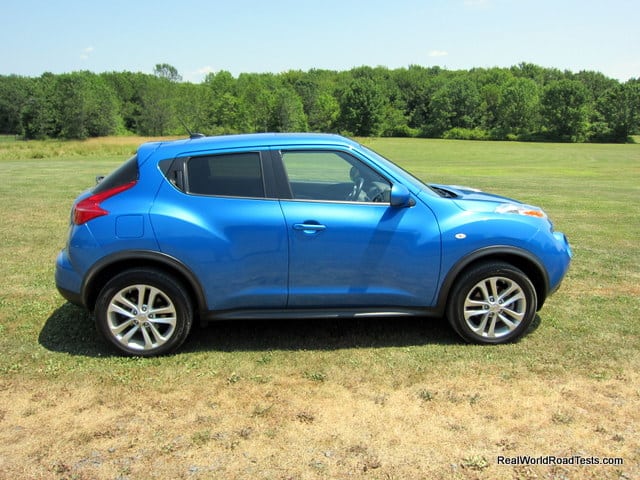
Above its high belt line, the Juke contains sporty elements, some of which are borrowed from other Nissan designs. Its windshield is raked. The coupe-like falling roofline is reminiscent of the GT-R. The rear door handles are hidden providing a sporty coupe-like appearance, and it has boomerang tail lights like the one’s on the latest generation Z.
Below the belt line, the Juke has a more SUV-like appearance. It has a broad shoulder line, large wheel arches, and standard 17” aluminum alloy wheels with all-season Goodyear Eagle RS-A P215/55R17 tires that are pushed out providing a solid stance. The Juke also has generous ground clearance of 7 inches.
One other aspect of the exterior of this car that makes it stand out is its color. Ours came in Electric Blue. This is definitely the most extroverted and exciting color Nissan offers in the Juke. If you want to stand out, this is the color to get.
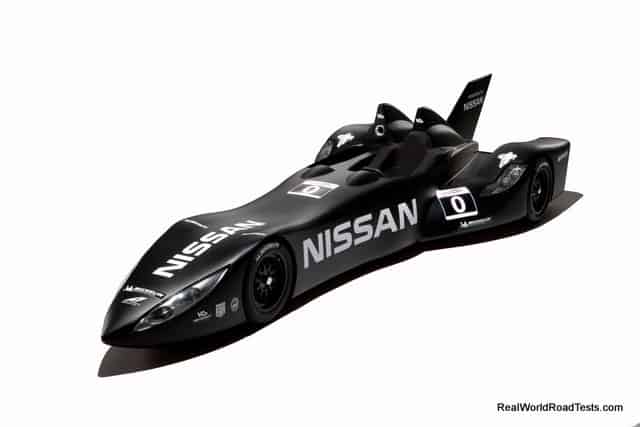
Juke aside, Nissan is no stranger to far out designs. There’s the Cube, the Murano CrossCabriolet, and the DeltaWing (not a production vehicle) just to name a few. The DeltaWing which is pictured above is a motoring innovation on track, and its success will help Nissan innovate vehicles off the track. With its lightweight and aerodynamic design, and smaller turbocharged engine, it uses less fuel, with less tire consumption, but retains the performance of its competitors. This is the direction the industry is going today and the DeltaWing is Nissan’s test vehicle for taking that technology to consumer cars it will develop in the future. (An intro piece for Highcroft Racing’s involvement and the DeltaWing can be read here.)
The Juke’s interior continues some of the sporty cues of the exterior, with a motorcycle inspired design. There is a flowing look to the top of the dashboard. The instrument cluster is shaded by a motorcycle inspired fairing and houses the s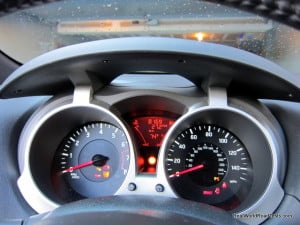 peedometer and tachometer, in between which is a digital readout for fuel level, odometer, trip computer info, temperature, and other useful information. The gear shift lever sits on top of a motorcycle fuel tank inspired center console that is elevated to provide a sports car-like shifter position. Costs are controlled in the Juke by using interior materials that are dominated by hard plastics that don’t feel rich, and the headliner and visors have a “budget” feel to them.
peedometer and tachometer, in between which is a digital readout for fuel level, odometer, trip computer info, temperature, and other useful information. The gear shift lever sits on top of a motorcycle fuel tank inspired center console that is elevated to provide a sports car-like shifter position. Costs are controlled in the Juke by using interior materials that are dominated by hard plastics that don’t feel rich, and the headliner and visors have a “budget” feel to them.
Entering and exiting the Juke is effortless with its Intelligent Key keyless entry, and elevated seating position. The bolstered 6-way manually adjustable perforated leather heated driver’s seat provides a good driving position with a commanding view of the road. I’m 6 feet tall and found no problem finding a comfortable driving position; although I wish I could bring the leather wrapped 3-spoke tilt steering wheel a tad closer, since it tilts but doesn’t telescope. The steering wheel does contain integrated audio controls and Bluetooth hands free phone operation. Headroom and legroom up front are also adequate for most adults. Unfortunately, there is no center armrest for either front occupant.
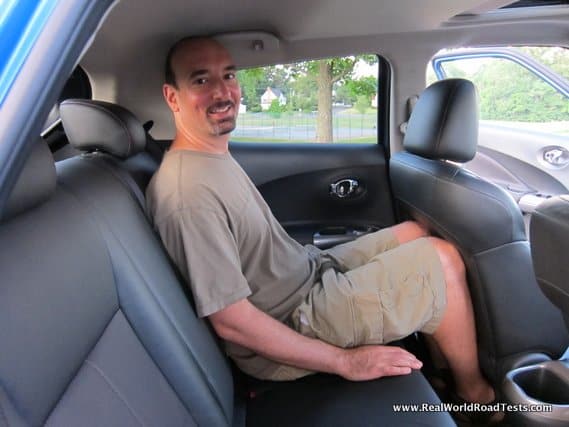
The rear seats are tight by SUV standards, and even when compared to other subcompacts such as the Honda Fit or Nissan’s own Versa. However it’s much roomier than the rear seats in sporty two door coupes such as the Ford Mustang. With the front seats adjusted for a 6 foot person, another 6-footer can fit behind the front seat occupant, but it will be tight, especially head-room wise where taller staff would hit their head on the liner. A maximum of two adults would fit in the rear with reasonable comfort as long as they’re not over 6 feet tall. With a rear facing infant car seat installed, front passengers over 5’4” will have to slide forward sacrificing their comfort up front.
Visibility is good overall. Forward visibility is enhanced due to a raised seating position. The protruding lights on the front fenders make it easy to tell where front of car is. The A-pillars are not too thick. The side mirrors are large and the rear-view camera equipped on our car did a nice job aiding reversing in parking lots and driveways. The C-pillar is thick but didn’t bother me.
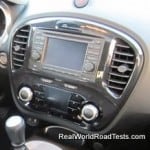
The center instrument console houses a 5.0 inch touch-screen and includes a Navigation system (with a removable SD card for map upgrades), XM capability, and rear view monitor. Below that is the Integrated Control (I-CON) system. All the controls are clearly marked, and easy to read and operate.
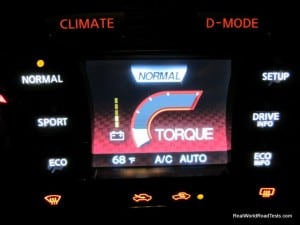 I-CON is the command center for the Climate and Drive Mode (D-Mode) settings. D-Mode allows the driver to choose between three drive modes (Sport, Normal, and Eco) that adjust the throttle, transmission (CVT only), and steering response settings. Normal is designed for everyday driving. Sport is for a more performance oriented feel, and Eco is for maximum efficiency.
I-CON is the command center for the Climate and Drive Mode (D-Mode) settings. D-Mode allows the driver to choose between three drive modes (Sport, Normal, and Eco) that adjust the throttle, transmission (CVT only), and steering response settings. Normal is designed for everyday driving. Sport is for a more performance oriented feel, and Eco is for maximum efficiency.
We find that the D-Mode is gimmicky. On public roads, it doesn’t provide any significant change in performance or feel, and the display doesn’t provide any useful information. It can also be distracting if you choose to look at it instead of at the road. In normal mode there is a torque meter that displays how much torque is being used. However, there are no numbers associated with the measurements. Sports mode shows boost. You can also display a G-force meter by pressing the Drive Info button. Again, there are no numbers associated with this, so it doesn’t tell you anything that you can’t already feel when you’re driving. Eco mode shows eco level. Press the Eco Info button and it displays a bar graph that shows your economy history.
![]() I-CON also houses the automatic climate controls. In Climate mode, the display magically changes from D-Mode to Climate and the lighting on all the buttons change to show the air flow preferences while the display screen shows the air temperature settings.
I-CON also houses the automatic climate controls. In Climate mode, the display magically changes from D-Mode to Climate and the lighting on all the buttons change to show the air flow preferences while the display screen shows the air temperature settings.
The Audio system on our car contains an upgraded six speaker system with a Rockford Fosgate subwoofer which sounds fine, but it still has the sound quality of a factory unit. Buyers in this segment would likely use this system a lot, so it’s nice that this upgraded unit is available. The Juke also comes equipped with a USB connection port for connecting some of your personal portable devices.
The Juke is powered by a 1.6 liter direct injected and turbocharged 4-Cylinder gasoline engine that makes 188 HP @ 5,600 RPM and 177 lb ft torque @ 2,000 – 5,200 RPM. Acceleration feels peppy and is a lot of fun! We were able to accelerate from 0-60 mph in 7.5 seconds. We tested on a hot and humid day so we’re pretty sure this time can be shortened by another half second or so. There is a little bit of turbo lag as it spools, and power builds slowly below 3,000 RPM. Once you hit 3,000 RPM though, power surges nicely to 6,000 RPM. Redline is at 6,400 RPM. For best acceleration runs, we would suggest revving the engine to 3,000 RPM before releasing the clutch.
To start the Juke, all you need is the key fob in your pocket, your feet on the clutch and brake, and your finger to press the start button on the dash. When accelerating, it is quieter than we expected it to be although we do hear it… and it remains smooth ’til the 6,400 RPM redline. It’s doesn’t have a deep throaty sound of a V8, nor a loud winey sound that you would expect from a tiny 4-cylinder. We are aware that we’re driving a 4-cylinder, but it does sound larger than 1.6 liters. Once it reaches a cruising speed, the sound is just another background noise along with the also noticeable (at highway speed) wind and road noise that is not too bothersome, although road noise over coarse pavement is pronounced.
Since we’re not a fan of CVTs (heck, we’re driving enthusiasts), we’re 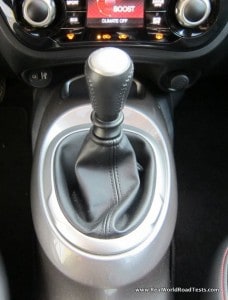 glad we were able to spend our time rowing the 6-speed manual transmission. The transmission shifts smoothly in all gears, and feels sporty too. The clutch uptake is on the heavier side, which takes a few minutes to get used to if you’re used to clutches with lighter uptakes, but it is easy to modulate. We did not have the opportunity to drive the CVT (Oh poor us!).
glad we were able to spend our time rowing the 6-speed manual transmission. The transmission shifts smoothly in all gears, and feels sporty too. The clutch uptake is on the heavier side, which takes a few minutes to get used to if you’re used to clutches with lighter uptakes, but it is easy to modulate. We did not have the opportunity to drive the CVT (Oh poor us!).
Handling is impressive for a taller vehicle. According to Thefreedictionary.com, the word “juke” means “to deceive or outmaneuver a defender by a feint. The Juke deceives us by making us think that since it’s a taller vehicle, it won’t change direction quickly or handle well. Handling is surprisingly sporty and athletic though, thanks to its independent MacPherson struts in front and a torsion bar in the rear both with stabilizer bars and twin tube shocks, wide track, and low profile tires. Throwing the Juke in corners is actually a lot of fun. The steering wheel is nicely weighted and the speed sensitive electric power steering provides good feedback. The 4-wheel disc brakes with ABS feel strong with a great pedal feel.
The downside to the impressive handling for a taller vehicle is that the ride is pretty firm and not that comfortable. On smooth roads, it was fine. Over small bumps, it’s fidgety. Moderate bumps can pound through the cabin.
The trunk in the Juke is small, but can be easily open with the key fob in your pocket, just by pressing a button on the lift gate. We found this feature very handy. It has 10.5 cubic feet of trunk space and is expandable to 35.9 cubic feet with the 60/40 spit folding rear seats folded flat. With the rear seats up, we were surprisingly able to squeeze an umbrella stroller in there, but with very little room to spare. Beneath the floor of the trunk in our FWD Juke is a handy hidden storage compartment not available in the AWD models. Other storage includes a bottle holder in each door. Below the center instrument console is a rubber lined tray designed to stow a cell phone or MP3 player. Unfortunately, there is no armrest/covered storage bin between the two front seats. There’s only a small storage tray with two cup holders instead.
Safety
Since the Juke was designed for the “Adventure” type, some may assume that safety wasn’t too much of a concern in the development of the Juke… and they’ll be wrong. The IIHS awarded the 2012 Juke a “Top Safety Pick” for 2012 and gave it a “Good” rating in front, side, rollover, and rear tests. Every 2012 Juke comes equipped with Nissan Advanced Air Bag System (AABS) with dual-stage, dual-threshold front air bags and seat belt and occupant classification sensors, roof-mounted curtain side-impact supplemental air bags for front and rear outboard occupant head protection, seat-mounted driver and front passenger side-impact supplemental air bags and front-seat Active Head Restraints, Tire Pressure Monitoring System (TPMS), Vehicle Dynamic Control (VDC) and Traction Control System (TCS).
Availability
The Juke is Assembled in Oppama, Japan, and is offered in eight models: Juke S CVT FWD or AWD, Juke SV CVT or M/T FWD, Juke SV CVT AWD, Juke SL CVT or M/T FWD, and Juke SL CVT AWD. Fuel economy is rated at 27 mpg City and 32 mpg Highway for the JUKE CVT FWD models, 27/32 mpg for the CVT FWD models, and 25/30 mpg for the CVT AWD models. SV models add a power sliding glass moonroof, intelligent key with push button ignition, I-CON, Serius XM satellite radio capability, and a leather wrapped steering wheel over the S models. SL models add a 5″ navigation system with touch screen, Rockford Fosgate powered 8″ subwoofer, USB connection, leather seats with heated front seats, and rear view monitor over SV models.
Starting prices are $19,990 for the Juke S, $21,610 for SV, and $23,990 for the Juke SL excluding destination and handling.
Summary
In a world where too many cars look the same, we praise Nissan for trying to do something different with the Juke. If their goal was really to have fun and do something different to turn the heads of a younger active crowd, then they’ve succeeded…although some of the heads they’ve turned may not have been in the direction they intended (hey, you can’t please everyone).
It does not have the utility of an SUV, but it’s more fun to drive than one, and it’s a more practical choice than a traditional 2-door sporty coupe. From a driving enjoyment prospective, we liked the Juke a lot. It was always fun to drive, the engine is surprisingly peppy, it’s maneuverable in tight spaces, the build quality feels solid and it makes you want to go out and have fun.
RealWorldRoadTests Second Opinion – Dave Gran
Love it! Hate it! Not sure what to make of it. Those were common reactions of other people who were exposed to the Juke. When driving around, it was obvious people were looking at the vehicle but it wasn’t clear was which reaction they had.
Many vehicle have become so bland and seem to all blend in together. While I personally found some of the Juke’s styling difficult to embrace, I appreciate the styling risks that Nissan took to produce such a bold looking vehicle. If you like its looks or can get past some of its quirkiness, I think you’ll be pleasantly surprised with the vehicle after driving it around a bit. While it’s not a fast vehicle, the 0 – 60 performance times don’t do it justice as it feels quicker than that. To compliment its peppyness, the Juke’s handling is precise and has no problem handling twisty roads.
Vehicle type: Front Engine, FWD, 5 Passenger, 4-Door
Base price (including destination): $24,160
Price as tested (including destination): $24,335
Horsepower: 1.6 Liter Direct Injected Gasoline Turbocharged 4-Cylinder 188 HP @5,600 RPM
Torque: 177 lb ft @ 2,000 – 5,200 RPM
Transmission: 6-Speed Manual
RWRT’s 0 – 60 MPH: 7.5 Seconds
EPA Rating (city/hwy/comb): 25/31/27
Recommended Fuel: Premium Unleaded
[nggallery id=32]
Receive Notification When Our Next Article is Posted – Subscribe Today!
Simply enter your e-mail address below then click on subscribe
(Your information will remain private)

